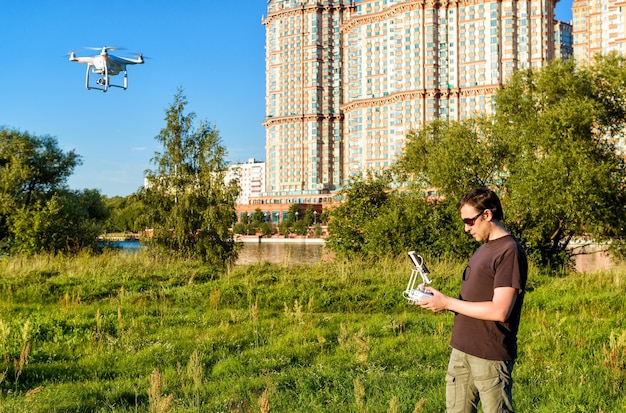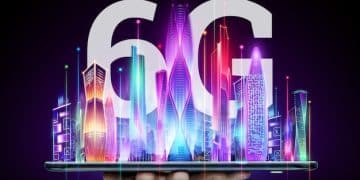The Impact of 5G on US Tech Innovation: A Comprehensive Guide

5G technology is poised to revolutionize future tech innovation in the US, enabling faster speeds, lower latency, and greater connectivity, impacting various industries and applications.
The Impact of 5G on Future Tech Innovation in the US is profound, promising to reshape industries and everyday life. This article explores the transformative potential of 5G technology and its impact on various sectors in the United States.
Understanding the 5G Revolution in the US
5G, the fifth generation of wireless technology, represents a significant leap forward from its predecessors. Its enhanced capabilities are set to unlock new possibilities for technological innovation across various sectors in the US.
But what exactly makes 5G so revolutionary and why is it considered a game-changer for future technologies?
Key Features of 5G Technology
5G is not just an incremental upgrade; it brings several key improvements that set it apart from previous generations:
- Higher Speeds: 5G offers significantly faster data transfer rates, potentially reaching several gigabits per second.
- Lower Latency: Reduced latency means near-instantaneous response times, crucial for applications like autonomous vehicles and augmented reality.
- Increased Capacity: 5G networks can handle a much larger number of connected devices simultaneously without compromising performance.
- Greater Reliability: Enhanced reliability ensures more stable and consistent connections, essential for critical infrastructure and industrial applications.
These advancements collectively pave the way for a new era of technological possibilities.
In essence, 5G’s ability to provide faster, more reliable, and more scalable connectivity is reshaping the landscape of future tech innovation in the US, creating new opportunities and applications.
5G’s Impact on Smart Cities and Infrastructure
The integration of 5G technology is set to transform urban environments, enabling the development of smart cities with enhanced infrastructure and improved quality of life for residents.
5G’s high-speed and low-latency capabilities are essential for realizing the full potential of smart city initiatives.

Enhancing Connectivity and Efficiency
5G facilitates seamless connectivity between various components of a smart city, including:
- Smart Transportation: Real-time traffic management, autonomous vehicles, and connected public transport systems.
- Smart Energy Grids: Efficient energy distribution, smart metering, and integration of renewable energy sources.
- Smart Waste Management: Automated waste collection, sensor-based monitoring of waste levels, and optimized recycling processes.
- Smart Public Safety: Enhanced surveillance, real-time emergency response, and improved communication between first responders.
These applications collectively contribute to creating more sustainable, efficient, and livable urban environments.
In essence, 5G’s ability to connect and optimize urban infrastructure is pivotal for the development of smart cities, offering enhanced services and a better quality of life for residents in the US.
Revolutionizing Healthcare with 5G Technology
5G technology is poised to revolutionize healthcare in the US, offering enhanced connectivity, faster data transfer, and lower latency, all of which are crucial for advancing medical practices.
The impact of 5G on healthcare is multifaceted, encompassing remote patient monitoring, telemedicine, and enhanced medical imaging.
Telemedicine and Remote Patient Monitoring
5G facilitates real-time, high-quality video consultations and remote monitoring of patients’ vital signs, enabling healthcare providers to deliver timely and effective care, especially in rural or underserved areas. This leads to:
-
Improved Access to Care: Patients in remote locations can consult with specialists without the need for extensive travel.
-
Enhanced Chronic Disease Management: Real-time monitoring allows for proactive intervention and personalized treatment plans.
-
Reduced Healthcare Costs: Telemedicine can lower the costs associated with in-person visits and hospital readmissions.
-
Better Patient Outcomes: Timely access to healthcare services leads to improved health outcomes and patient satisfaction.
In conclusion, 5G’s capabilities are enhancing telemedicine, remote patient monitoring, and medical imaging, leading to more efficient, accessible, and effective healthcare services in the US.
Advancing Autonomous Vehicles through 5G
5G technology is a cornerstone for the advancement of autonomous vehicles in the US, providing the necessary infrastructure for real-time communication, high-speed data transfer, and ultra-low latency.
The integration of 5G enhances the safety, efficiency, and reliability of autonomous vehicles.

Real-Time Data Processing and Communication
5G enables autonomous vehicles to process vast amounts of data in real-time and communicate with other vehicles, infrastructure, and cloud-based systems, which are critical to:
-
Enhanced Safety: Real-time data exchange helps prevent accidents and improves overall road safety.
-
Optimized Traffic Flow: Communication between vehicles allows for dynamic adjustments to traffic patterns.
-
Improved Navigation: Real-time updates on road conditions and traffic incidents ensure smoother navigation.
-
Greater Efficiency: Autonomous vehicles can optimize routes and reduce fuel consumption, contributing to environmental sustainability.
In summary, 5G’s capabilities are crucial for enhancing the safety, efficiency, and reliability of autonomous vehicles, paving the way for their widespread adoption in the US.
5G’s Role in Augmented and Virtual Reality
5G technology is set to revolutionize augmented reality (AR) and virtual reality (VR) experiences in the US, providing the bandwidth and low latency necessary for immersive and interactive applications.
The integration of 5G enhances the realism, responsiveness, and accessibility of AR and VR technologies.
Enhancing Immersive Experiences
5G’s high-speed and low-latency connections enable real-time rendering of high-resolution graphics, seamless streaming of 360-degree videos, and interactive multiplayer experiences, fostering:
-
Entertainment: Immersive gaming, virtual concerts, and interactive storytelling.
-
Education: Virtual field trips, augmented learning materials, and remote collaboration in virtual environments.
-
Training: Realistic simulations for medical, engineering, and military training.
-
Retail: Virtual try-ons, augmented product demonstrations, and immersive shopping experiences.
In essence, 5G’s capabilities are enhancing the realism, responsiveness, and accessibility of AR and VR technologies, opening up new possibilities across entertainment, education, training, and retail sectors in the US.
The Future of Manufacturing with 5G Integration
5G technology is transforming the manufacturing industry in the US by enabling smart factories, predictive maintenance, and enhanced automation, leading to increased efficiency, reduced costs, and improved quality control.
The integration of 5G facilitates real-time monitoring, data analysis, and remote control of manufacturing processes.
Smart Factories and Automation
5G enables seamless connectivity between machines, sensors, and control systems, integrating:
-
Predictive Maintenance: Real-time monitoring of equipment performance, detecting potential failures before they occur.
-
Remote Monitoring: Accessing and controlling operations from any location, optimizing production processes effectively.
-
Automation: Using collaborative robots and automated systems to perform repetitive or tasks requiring accuracy.
-
Customization at Scale: Flexible manufacturing processes to meet individual needs.
Ultimately, 5G’s capabilities are enhancing efficiency, reducing costs, and improving overall performance in the manufacturing industry, paving the way for a new era of smart, connected factories in the US.
Challenges and Opportunities in 5G Deployment in the US
While the potential benefits of 5G are significant, the deployment of 5G technology in the US faces challenges, with opportunities for innovation and overcoming obstacles.
Successful deployment will require addressing regulatory issues, infrastructure limitations, and cybersecurity concerns.
Navigating Regulatory Hurdles and Infrastructure Limitations
Ensuring the widespread availability of 5G will require coordination between government, industry, and other stakeholders to address matters like:
-
Spectrum Allocation: Allocating a great deal of spectrum to mobile carriers is paramount to guarantee optimal performance.
-
Infrastructure Investment: Massive investment in infrastructure, especially in rural/underserved regions, is necessary for reliable 5G coverage.
-
Regulatory Clarity: Establishing clear regulations that foster a level playing field is important to promote investment.
-
Cybersecurity: Establishing cybersecurity measures is essential for protecting sensitive data while maintaining network transparency.
In short, successful implementation of 5G will require a unified effort to get around challenges and make the most of 5G’s transformative capabilities. This may open innovative opportunities and ultimately influence the future of technology.
| Key Aspect | Brief Description |
|---|---|
| 🚀 Higher Speeds | 5G offers significantly faster data transfer rates, reaching several gigabits per second. |
| ⏱️ Lower Latency | Reduced latency means near-instantaneous response times, crucial for real-time applications. |
| 🌐 Smart Cities | 5G enables smart transportation, efficient energy grids, and advanced public safety systems. |
| 🏥 Healthcare | 5G revolutionizes healthcare with telemedicine, remote patient monitoring, and enhanced medical imaging. |
Frequently Asked Questions
▼
5G is the fifth generation of wireless technology, designed to provide faster speeds, lower latency, and greater capacity compared to previous generations. It is set to transform various industries and applications.
▼
5G enables seamless connectivity between various components of a smart city, including transportation, energy grids, waste management, and public safety systems, optimizing urban infrastructure and services.
▼
5G revolutionizes healthcare with telemedicine, remote patient monitoring, and enhanced medical imaging, enabling healthcare providers to deliver timely and effective care, especially in remote or underserved areas.
▼
5G enables real-time data processing, communication, and enhanced safety features for autonomous vehicles, optimizing traffic flow and improving navigation through constant road updates.
▼
5G provides the bandwidth and low latency necessary for immersive and interactive augmented reality (AR) and virtual reality (VR) experiences, enhancing the realism, responsiveness, and accessibility of these technologies.
Conclusion
In conclusion, the impact of 5G on future tech innovation in the US is profound, with the potential to transform industries, enhance urban living, and improve healthcare, autonomous vehicles, augmented and virtual reality, and manufacturing.





